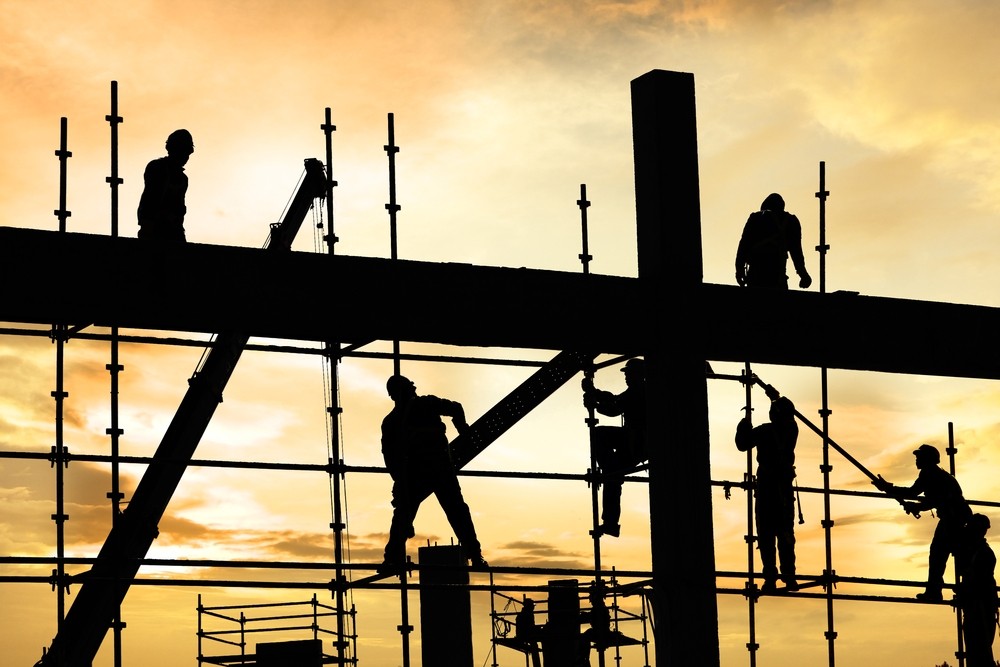Safety Risks In Construction

Safety risks are a part of every occupation, but construction sites are especially full of hazards. The Occupational Safety and Health Administration (OSHA) is committed to offering information to all construction companies on properly training their workers. Safety training and constant enforcement of regulations are important to keep construction sites safe.
Electrical
The use of large equipment on construction sites puts many workers in danger of electrical shock. Workers who come within 10 feet of electrical wires and do not call utility companies before digging run a high risk of electrical shock. Also, not using wood or fiberglass ladders--which don't conduct electricity--can increase electrical hazards.
Falls
Falls are the number one cause of deaths in the construction industry. Sides and ledges that are unprotected offer a danger of falling, as do floor holes that are not covered or guarded. Workers on scaffolds without proper fall protection run a risk of falling.
Struck-by and Caught Between
Heavy equipment striking workers is the cause of 75 percent of struck-by fatalities. Any object that can forcefully strike a worker--such as vehicles, falling objects and masonry walls--pose serious safety hazards. The objects also offer the risk of pinning or catching an employee between two spaces. In these situations, amputation, scalping and even death can occur.
Trenching and Excavation
A trench is a safety risk because it is deeper than it is wide, meaning the area inside it is confined. The most feared trenching accident is a cave-in. Vibrations from equipment can make soil around that confined area unstable and cause it to give way. Another concern with trenching and excavation is insufficient oxygen in the space, causing suffocation. Other hazards include toxic fumes and drowning.
Electrical
The use of large equipment on construction sites puts many workers in danger of electrical shock. Workers who come within 10 feet of electrical wires and do not call utility companies before digging run a high risk of electrical shock. Also, not using wood or fiberglass ladders--which don't conduct electricity--can increase electrical hazards.
Falls
Falls are the number one cause of deaths in the construction industry. Sides and ledges that are unprotected offer a danger of falling, as do floor holes that are not covered or guarded. Workers on scaffolds without proper fall protection run a risk of falling.
Struck-by and Caught Between
Heavy equipment striking workers is the cause of 75 percent of struck-by fatalities. Any object that can forcefully strike a worker--such as vehicles, falling objects and masonry walls--pose serious safety hazards. The objects also offer the risk of pinning or catching an employee between two spaces. In these situations, amputation, scalping and even death can occur.
Trenching and Excavation
A trench is a safety risk because it is deeper than it is wide, meaning the area inside it is confined. The most feared trenching accident is a cave-in. Vibrations from equipment can make soil around that confined area unstable and cause it to give way. Another concern with trenching and excavation is insufficient oxygen in the space, causing suffocation. Other hazards include toxic fumes and drowning.
- 4obbc56bdc1efdbdf7f9bf2d85347584d9.jpg
- nd70d1a884976682a22b965a5af9f15be0.jpg
- qm84e34170e09969813ab5b68760180a00.jpg
References
http://www.ehow.com/list_6454955_safety-risks-construction.html
http://www.rmmagazine.com/wp-content/uploads/2012/09/construction.jpg
http://img.ehowcdn.com/article-new-thumbnail/ehow/images/a06/4v/lb/safety-risks-construction-1.1-800x800.jpg
http://www.careerstructure.com/careers-advice/trends/~/media/risks.ashx